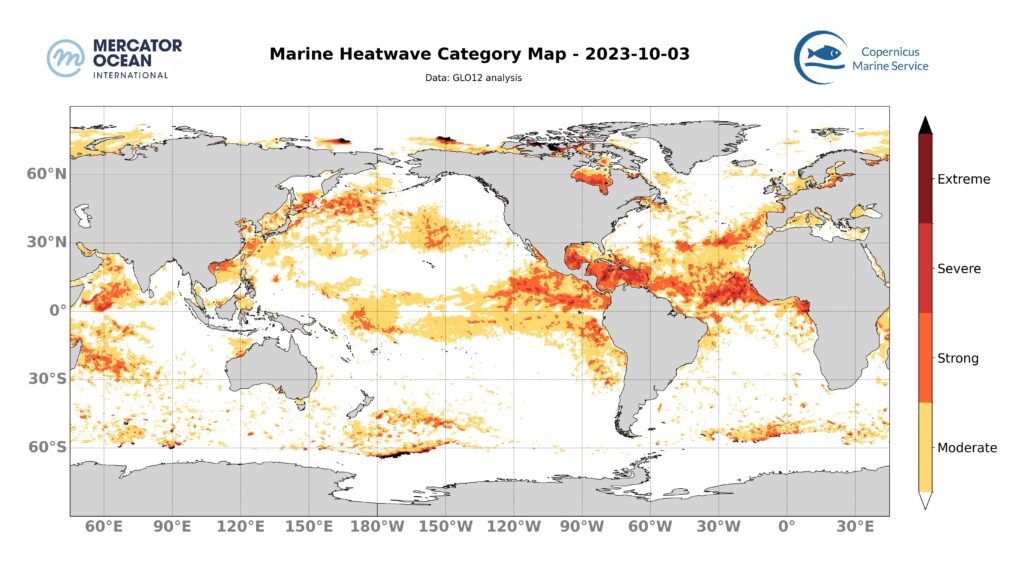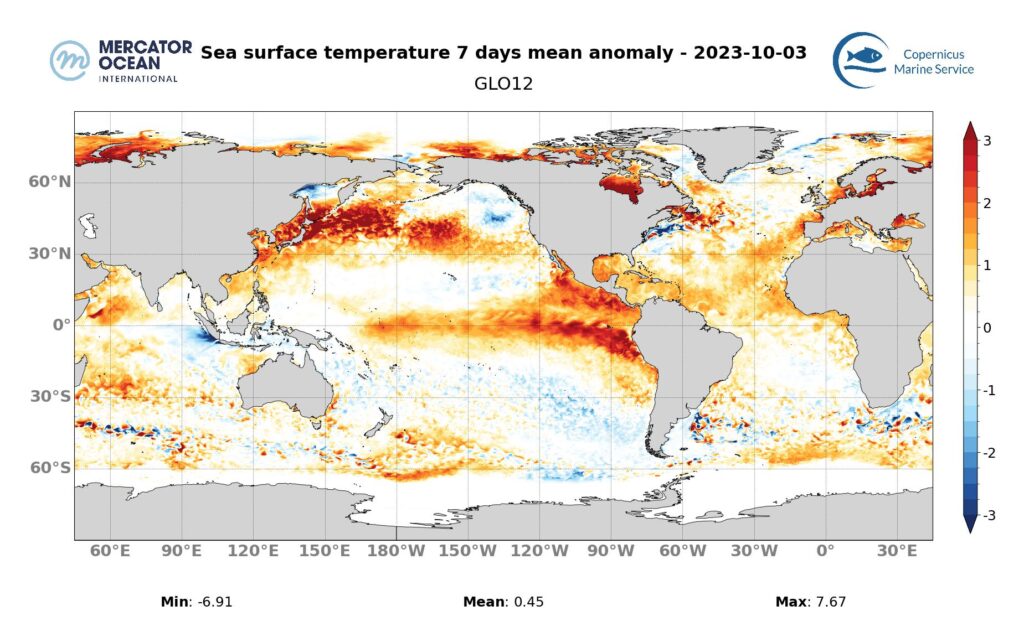Mercator Ocean International (MOi) oceanographers examine marine heatwaves across the global ocean. They analyse a variety of datasets from observation analyses (satellite sea surface temperature maps) to model analyses (assimilating satellite and in situ observations) and model forecasts.¹


Assessment for October 03
- Europe zone:
- The marine heatwave which has been raging along the Atlantic coast since last week has extended, covering a large area from the Iberian Peninsula to Scandinavia, evolving from moderate to moderate to strong levels, particularly off the Iberian Peninsula.
- The forecast return of a heatwave in the western Mediterranean is confirmed, affecting most of the area from the Strait of Gibraltar to the Italian peninsula, with moderate to locally strong levels. In the eastern part of the basin, last week’s heatwave is dissipating. Along the Atlantic seaboard and in the western Mediterranean, weekly temperature anomalies range from 1.5°C to over 3°C locally.
- Global zone:
- In the Tropical Atlantic, the heat wave still covers most of the area. As forecasted in the previous bulletin, the eastern part is intensifying with strong to severe levels. The associated temperature anomalies are of the order of 1°C to 2°C. The heatwave in the Gulf of Mexico and the Caribbean Sea remains at a high level, in the strong to severe category for the whole area. Weekly temperature anomalies are around 1.5°C.
- In the Tropical Pacific, the El Niño heatwave continues. The weekly temperature anomaly in the eastern part of the basin is around 3°C.
- The heatwave in the North Pacific is still present at a moderate, locally strong level in the centre of the basin. Weekly temperature anomalies are around 2°C in the central part, but can reach up to 3°C in the western part.
- In the western Indian Ocean, the heat wave remains stable off Madagascar and in the Arabian Sea, with strong to severe categories and weekly temperature anomalies of around 1°C to 2°C.
Forecasts for up to October 10
- Europe zone :
- For October 10, the Mercator Ocean International (MOI) forecasting system predicts an intensification of the marine heatwaves in Europe. In the western Mediterranean, the heat wave is becoming more intense, with more intense categories and more widespread in the northern part of the basin.
- The heatwave on the Atlantic coast will reach moderate to severe categories overall, from the Iberian Peninsula to the English Channel. This wave extends beyond the European zone over the eastern coast of the basin, as far as the tropical North Atlantic zone.
- Global zone:
- For 10 October, MOI forecasts an intensification of the heatwave in the Tropical Atlantic, which will increase in intensity, with severe and extreme categories in the Caribbean Sea, as well as an extension of areas in the strong category from the Iberian Peninsula to the centre of the basin.
- In the Tropical North-Eastern Pacific, the heatwave is diminishing off Mexico, with less extensive areas in the strong category.
- The heatwave in the Northern Pacific remains present in the centre of the basin.
- The heat wave in the Western Indian Ocean remains stable.
What are marine heatwaves?
Marine heatwaves (MHW) are extreme rises in ocean temperature for an extended period of time. They can occur at different locations in the ocean, and their magnitude and frequency have increased over the last couple of decades, with harmful impacts on ecosystems, and human activities. According to the latest report released by the Intergovernmental Panel on Climate Change (IPCC AR6 SYR), it is found with high confidence that in the near-term at 1.5°C global warming, the increasing frequency of marine heatwaves will increase risks of biodiversity loss in the oceans, including from mass mortality events.2
How are marine heatwaves calculated?
A marine heatwave is a heat episode during which the temperature is significantly higher than a certain threshold for at least 5 consecutive days.

The seasonally-varying threshold is defined on a daily basis according to a sufficiently long climatic period (in this case 1993-2016). So, for a given place and a given day, knowing all the surface temperatures observed over the last 30 years, a heatwave situation is defined as one where the temperature measured is within 10% of the maximum values observed (i.e. above the 90th quantile, see diagram), for at least 5 consecutive days.
The main characteristics of heatwaves are their duration and intensity. The intensity for a given day corresponds to the value in degrees above the 90th quantile (blue arrow), which can either be calculated as the cumulative intensity throughout the heatwave event, or the maximum intensity.
Heatwaves are categorised on the basis of their deviation from the mean temperature or anomaly (green arrow): a deviation of more than 2 times the difference between the 90th quantile and the mean corresponds to a heatwave in the strong category; a deviation of more than 3 times corresponds to a heatwave in the severe category; and a deviation of more than 4 times corresponds to a heatwave in the extreme category.
¹Analysis of datasets: OSTIA sea surface temperature observations analysis (Copernicus Marine Service), OISST sea surface temperature observations analysis (NOAA), GLO12 model (Copernicus Marine Service, Mercator Ocean International)
² IPCC AR6 SYR 4.3 https://www.ipcc.ch/report/ar6/syr/downloads/report/IPCC_AR6_SYR_LongerReport.pdf
